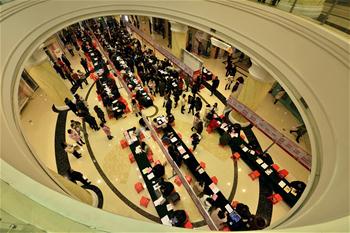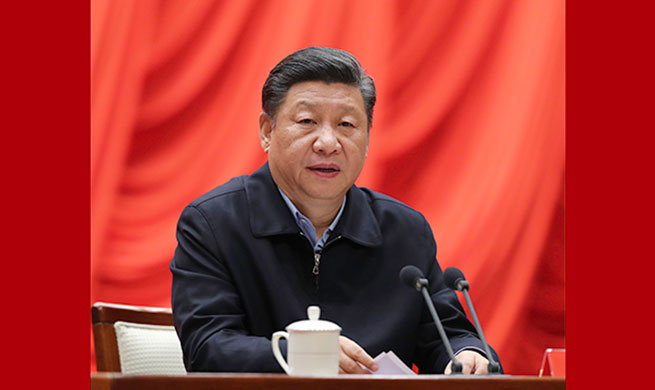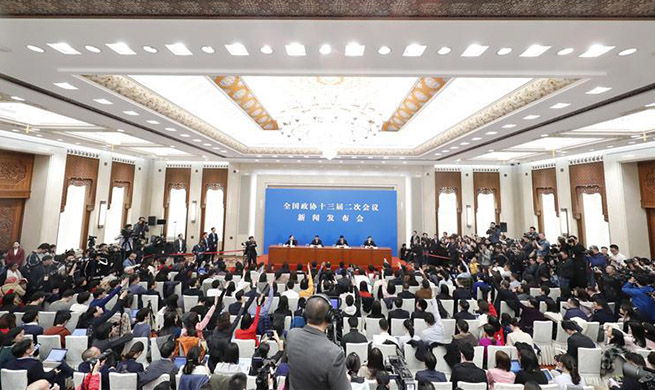NEW YORK, March 2 (Xinhua) -- U.S. stocks wrapped up the week on a decent note, as the market was underpinned by progress made in the latest U.S.-China trade negotiations, while investor sentiment was dented by a batch of mixed data, including slower U.S. economic growth in the fourth quarter of 2018.
In the week ending March 1, the Dow fell 0.02 percent, the S&P 500 was up 0.40 percent, and the Nasdaq gained 0.90 percent.
This week marked slightly choppy trading sessions for the market with an upbeat start and a high ending. On Friday, the three major indices ended higher, eroding most of the losses during the week, as the market was backed by stronger-than-expected corporate earnings in the fourth quarter and a slight rebound in consumer sentiment.
Friday extended solid gains throughout the day, as a series of better-than-expected quarterly earnings of U.S. companies helped the market close out the week positively.
The Dow Jones Industrial Average increased 110.32 points, or 0.43 percent, to 26,026.32. The S&P 500 was up 19.20 points, or 0.69 percent, to 2,803.69. The Nasdaq Composite Index was up 62.82 points, or 0.83 percent, to 7,595.35.
Shares of Dentsply Sirona dramatically rose nearly 17.7 percent around market close on Friday, after the U.S. dental equipment maker posted strong fourth-quarter earnings and sales that beat market expectations.
Shares of Foot Locker also increased nearly 6 percent on Friday, after the U.S. athletic footwear and apparel retailer posted fourth-quarter earnings results that topped market forecasts.
The market has also been buoyed by growing optimism about the prospect of trade relations to be made between the United States and China, as investors have kept a close eye on the latest round of bilateral talks between the two countries.
Negotiators of the two sides have achieved marked advancement on specific issues in their Feb. 21-24 talks in Washington, the seventh round since February last year, covering non-tariff barriers, agriculture and service industry, technology transfer, protection of intellectual property rights, and exchange rates, the Chinese delegation said on Feb. 24.
U.S. President Donald Trump tweeted on Sunday that he "will be delaying" tariff hikes on Chinese imports previously scheduled for March 1, citing "very productive" trade talks between the two countries.
"So all the time traders have information flowing to them saying that things are going positively between China and the United States, everyone wants to see a deal come out of this," said Mark Otto, an experienced trader at the New York Stock Exchange and a global market commentator at GTS, a leading electronic market maker across global financial instruments.
However, Thursday was the day for the Wall Street to mourn, as the market was weighed down by weakening U.S. economic growth rate in the last quarter of 2018.
Although the U.S. fourth-quarter economic growth exceeded the forecasts of analysts surveyed by Dow Jones, the 2.6 percent reading was still lower than the third-quarter's 3.4 percent rate, the Commerce Department said Thursday.
The quarterly result came as consumer spending growth rate declined to 2.8 percent in the fourth quarter, down from the previous quarter's 3.5 percent.
Consumer spending accounts for roughly two thirds of the overall U.S. economy.
In contrast, exports rose at a rate of 1.6 percent in the fourth quarter, rebounding from a decline of 4.9 percent in the third. Nonresidential fixed investment also increased at 6.2 percent in the fourth quarter, up from a 2.5 percent rise in the third.
Geopolitical tensions during the week also added to market concerns.
Troops of India and Pakistan exchanged heavy fire and targeted each other's positions on Line of Control dividing the disputed Kashmir region on Wednesday local time, officials said.
Since Wednesday, the market has closely observed the latest summit between U.S. President Donald Trump and top leader of Democratic People's Republic of Korea Kim Jong Un in Hanoi, who intended to discuss concrete ways for peace and denuclearization of the Korean Peninsula.
However, differences over details of denuclearization and easing of sanctions hindered Kim Jong Un, top leader of the DPRK, and U.S. President Donald Trump from reaching an agreement on Thursday. Yet their respective teams "look forward to meeting in the future."
Wall Street also digested a slew of key economic data.
The University of Michigan consumer sentiment index slightly bounced back to 93.8 in February, up from January's low of 91.2 due to U.S. government shutdown, the university said in a survey released on Friday.
However, the reading, as a key indicator to gauge consumer confidence in America, came shy of analysts' forecasts for the month across the board.
The ISM Purchasing Managers' Index (PMI) declined to 54.2 percent in February, a decrease of 2.4 percentage points from the January reading of 56.6 percent, the Institute for Supply Management (ISM) said in its latest Manufacturing ISM Report on Business released on Friday, indicating the country's manufacturing activity growth shrank last month.
The index reached its lowest level of expansion since November 2016, which was mainly dragged by a slowdown in both production growth and employment growth in the month, according to the report.
The ISM PMI has been a key indicator of economic health for manufacturing and service sectors. A reading above 50 percent indicates that the manufacturing economy is generally expanding, while below 50 percent indicates that it is generally contracting.
U.S. weekly jobless claims, or the number of Americans applying for unemployment benefits, sharply rose 8,000 to 225,000 in the week ending Feb. 23, the Labor Department said Thursday.
The four-week moving average was 229,000, a decrease of 7,000 from the previous week's revised average, which is, however, still higher than January's levels.
The Chicago Purchasing Managers Index (PMI), also known as Chicago Business Barometer, rose sharply in February, as new orders registered a double-digit increase.
The index accelerated to 64.7 in February, up 8 points from January's 56.7, marking the highest since December 2017, according to a statement released Thursday by the Institute for Supply Management Chicago.
U.S. deficit of international goods in trade surged 12.8 percent to a much larger-than-expected 79.5 billion U.S. dollars in December 2018, as exports fell 2.8 percent in the month to 135.7 billion dollars, the U.S. Census Bureau said Wednesday.
Adding to the downward trade pull from exports is a 2.4 percent rise in imports to 215.2 billion dollars, according to the bureau's latest monthly advanced economic indicators report.
U.S. housing starts sank 11.2 percent in December 2018 to a seasonally adjusted annual rate of 1,078,000, the Department of Commerce reported on Tuesday.
The reading is the lowest level since September 2016, missing market consensus.
Yet the Conference Board's consumer confidence index rose to 131.4 in February, which is nearly 10 points above January's revised level of 121.7 to end three straight months of decline, beating market expectations.

















